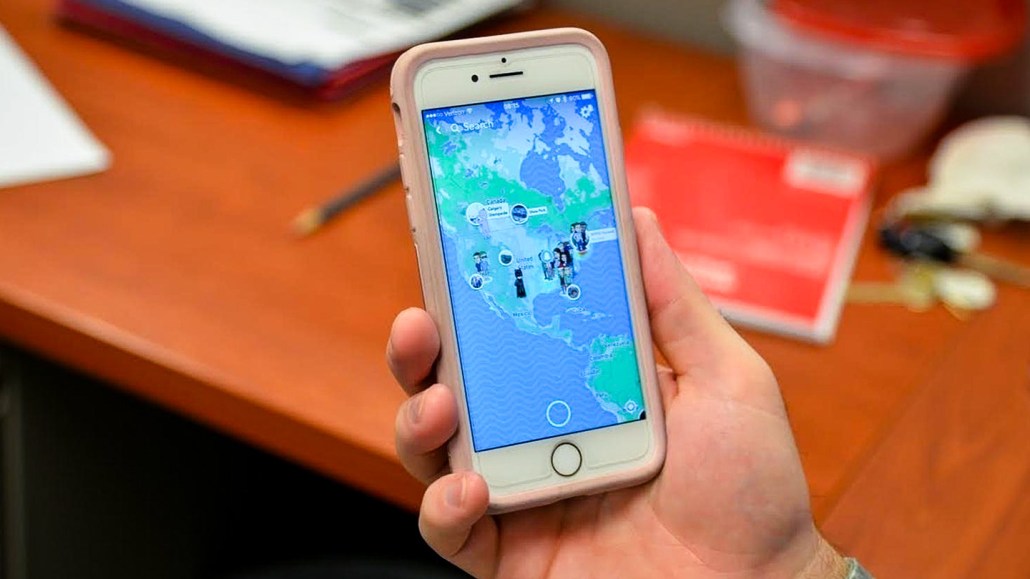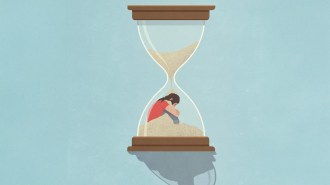Online spaces may intensify teens’ uncertainty in social interactions
Digital interactions differ from real-life ones, complicating social identity

A feature on Snapchat lets people track their friends’ locations in real time. That can leave people feeling left out in concrete, quantifiable ways.
Bob Collet / Alamy Stock Photo
Deciphering other people’s thoughts and feelings tends to generate considerable uncertainty. In a conversation, for instance, how does one know if another person’s smile is sincere? In real life, physical cues like body language and tone of voice provide some tangible hints. In the virtual sphere, a smile takes the form of an even harder-to-read emoji. And all physical cues disappear.
How people experience — and resolve — social uncertainty is changing shape as communications shift online, researchers write in the April Trends in Cognitive Science. That shift affects everyone. But teens, who are just starting to form their social identities, might be particularly vulnerable.
How vulnerable is unclear because research into social uncertainty in online spaces is practically nonexistent; there’s “a massive gap” there, says Amanda Ferguson, a clinical psychologist at the University of Cambridge. “This is the first theoretical piece published on the topic.”
Ferguson’s paper expands on a May 2019 review of how people resolve social uncertainty in systematic, measurable ways. For instance, when considering whether to lend a stranger money, a person initially forms a crude first impression, such as “This person looks trustworthy.” They then update that initial view, perhaps by chatting with the individual or learning about their past behavior from a mutual acquaintance.
In that piece, Oriel FeldmanHall and Amitai Shenhav, both of Brown University in Providence, R.I., focused entirely on in-person interactions. Research into uncertainty in social settings is itself a relatively new area of study — and does not yet include of how people resolve uncertainty online, says FeldmanHall, a social neuroscientist. “There’s been relatively no work in that domain.”
What is known is that misreading social cues can lead to social exclusion and loneliness so learning to navigate social situations is foundational to well-being (SN: 2/20/24). Science News spoke with Ferguson about the need for research into how people, particularly teens, resolve social uncertainty online. This interview has been edited for length and clarity.
SN: What made you want to look at how teens experience uncertainty in online spaces?
Ferguson: The research on this topic has been largely around this idea of dose, like dose of social media, and some mental health outcome. [Researchers] measure things like time spent online, frequency of use, duration of use, numbers of times [a page is] checked, that sort of thing. The literature tends to suggest that [mental health] effects, if they are found … tend to be small.
However, the size of that effect grows in certain age groups. For girls, I believe it’s 11 to 13; for boys it’s a little older, 14, 15; and then both at 19. [We’re] trying to understand what might make some people at higher risk than others. Time spent is too blunt a measure [to know what teens are feeling while online]. So one of the mechanisms that we are interested in is this idea of social uncertainty. It’s just so much harder to make sense of what people are thinking and feeling when you are communicating with them digitally than it is in person.
SN: You note that when people communicate online, social uncertainty goes up and down. Can you explain?
Ferguson: Social information around group structure and status becomes increasingly certain online, whereas really important social information that goes into how we view ourselves … is much more uncertain.
Offline cues related to social status … are kind of ambiguous. Who is wearing the latest trainers? Who has got the most friends, the most popular at school. They are not quantified, concretized, in the way that they are in social media where you have a number of followers, you have a number of friends, you have responses to each other’s comments. For example, Snapchat has a feature. It tracks people. You can see if all of your friends are in the same place, which can feel really bad. You’re left out in a way that feels really concrete.
[Meanwhile], a lot of the time, in-person communication is face-to-face and synchronous. Digital communication, you can send messages whenever. What that means is that all of a sudden somebody could stop responding. And that could be because they took their kids out, they went to sleep, they didn’t like what you said, or they didn’t know how to respond. It could be anything.
SN: How do you study the way people experience and deal with social uncertainty online?
Ferguson: We are just in data collection on a study. We straight up ask teens ages 13 to 18 several times a day if they have experienced social uncertainty in real life and online. [For instance, we ask], have you felt left out of something on social media? How hard is it to know what people are thinking and feeling?
We also have an experiment to manipulate status and uncertainty in different directions and see how it affects people’s behavior. That’s still very early stages.
SN: Why is it important to understand how this shift to online communication is affecting young people?
Ferguson: Imagine a young person, I don’t know if this person exists, but like a 10-year-old who has never been on social media. All they know is their classroom. They then go into a new school that is entirely online, and they can only communicate with people virtually. That’s where they are going to be developing their sense of identity and figuring what people think of them and who they are in the world. And the type of information that you get online just has a different set of characteristics than offline information.
For example, if somebody is angry with you in person, there are lots of ways to express anger. It doesn’t always look the same, but the cues are usually more salient. There are ways to express anger online that don’t have an obvious analog in the offline world. For example, [a message seemingly] being left unread could indicate that someone is angry with you [or] that someone is busy or sleeping. So in the online world, it is harder to pin down what others are thinking and feeling. It is possible that the beliefs of someone who learned this way, their conceptualization of what anger is, might be really broad with mushy edges.
There’s a lot for us to learn about how shifting to a mostly digital social world, or even a partly digital social world, affects critical social development, [such as] interpersonal skills, communication and emotional regulation.







